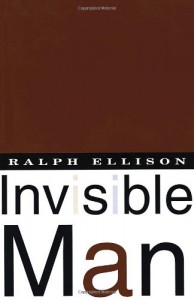Bloodorange
I'm a GoodReads user testing new waters after the serious website changes. I mostly read fiction, usually Anglophone classics/ modern classics; I like nonfiction (mostly social and cultural history), good fantasy and graphic novels. For guilty pleasure, I read advice and how-to books.
I made at least two reading resolutions recently; 1. read less, live more; 2. read books which give me more pleasure. I have poor filters, and books I find stylistically pleasing tend to be depressing, so I need to do something about that; if you think you know a book that is very well written, but won't make me weep, please drop me a line.
Invisible Man
 1. I had 39 status updates from this one, most of them quotations. This book is highly quotable. I'm not even sure Invisible Man is a 'good' - i.e. traditional - novel (I will consider this in a moment), but the quotability of this!
1. I had 39 status updates from this one, most of them quotations. This book is highly quotable. I'm not even sure Invisible Man is a 'good' - i.e. traditional - novel (I will consider this in a moment), but the quotability of this! The rhythm of this! (sorry, long sentence ahead, soNow I know men are different and that all life is divided and that only in division is there true health.
(this formatted fragment comes from Ms. Sandra Effinger's materials on Invisible Man from http://mseffie.com/assignments/invisible_man/As I drove,
faded and yellowed pictures of the school’s early days displayed in the library flashed
across the screen of my mind,
coming fitfully and fragmentarily to life --
photographs of men and women in wagons drawn by mule teams and oxen,
dressed in black, dusty clothing,
people who seemed almost without individuality,
a black mob that seemed to be waiting,
looking with blank faces, and
among them the inevitable collection of white men and women in smiles,
clear of features,
striking,
elegant and
confident.
2. The novel is episodic - in fact many chapters, such as Chapter 10 (paint factory), could be anthologized and read in separation. My impression is that Ellison was not really a novel-writer; he would typically write shorter fiction or non-fiction, and this book feels like an amalgam of different speeches, notes, stories, symbolic situations or encounters. Still, this isn't a picaresque novel - it is, in a way, a Bildungsroman, in which the protagonist, very typically of the form, grows to understand his place in the society.
And now all past humiliations became precious parts of my experience, and for the first time, leaning against that stone wall in the sweltering night, I began to accept my past and, as I accepted it, I felt memories welling up within me. It was as though I'd learned suddenly to look around corners; images of past humiliations flickered through my head and I saw that they were more than separate experiences. They were me; they defined me. I was my experiences and my experiences were me (...)
3. The symbolism is very far from subtle (rather, it's one of those situations when you are caught unawares by a symbolic object, again and again, and then every next symbol is greater, and more in your face, and then you're afraid for the narrator to actually look at things because NOOOOO ANOTHER SYMBOL IS COMING AT ME - but in a good way. This is junk food symbolism, easy, pleasant, and satisfying.
4. One of the things that saves this symbolism from being completely in-your-face is the surrealism. The narrator's voice in the beginning reminds me of Holden Caulfield's in its rawness, then starts resempling one of Kurt Vonnegut's narrators (which, luckily, passes). The battle royal, which opens the novel, is surreal, but there are many more instances of this. The Sambo bank section is surreal. Jim Trueblood "Southern gothic" story. The brothel chapter. The 'fantasy rape' scene. The lobotomy chapter (in which a doctor, seeing his black patient writhing from ECT, remarks “They really do have rhythm, don't they?")
5. The racism. All kinds and shades of racism. This book is a catalogue of the black experience, a catalogue of responses to it - from perceiving black Americans as being "the machine within the machine", the disappearance of which would effectively paralyse the entire nation, through the 'Uplift' blacks, to black men, victims of trigger-happy policemen, to lying black educators and administrators manipulating the whites under the facade of obedience and gullibility.
The uncertainty in relations with the whites ("...Is it an insult when one of us tips one of them?") and the racist non-racists:You let the white folk worry about pride and dignity you learn where you are and get yourself power, influence, contacts with powerful and influential people then stay in the dark and use it!
6. The critique of the Uplift movement: the deeply engrained mistrust of one's own race and the desire to out-white the whites. And then the scene in which the unnamed narrator walks down the street and orders a yam (a symbol, again, of the embraced black heritage)."The Brother does not sing!" Brother Jack roared staccato.
"Nonsense, all colored people sing."
"This is an outrageous example of unconscious racial chauvinism!" Jack said.
Quotation to give you a taste of Ellison's style:
"... white folks seemed always to expect you to know those things which they'd done everything they could think of to prevent you from knowing. The thing to do was to be prepared as my grandfather had been when it was demanded that he quote the entire United States Constitution as a test of his fitness to vote. He had confounded them all by passing the test, although they still refused him the ballot..."
Quotation which encapsulates the book's message on race relations in the U.S.:
Our fate is to become one, and yet many -- This is not prophecy, but description.
Thanks to Linda for a great buddy read!






